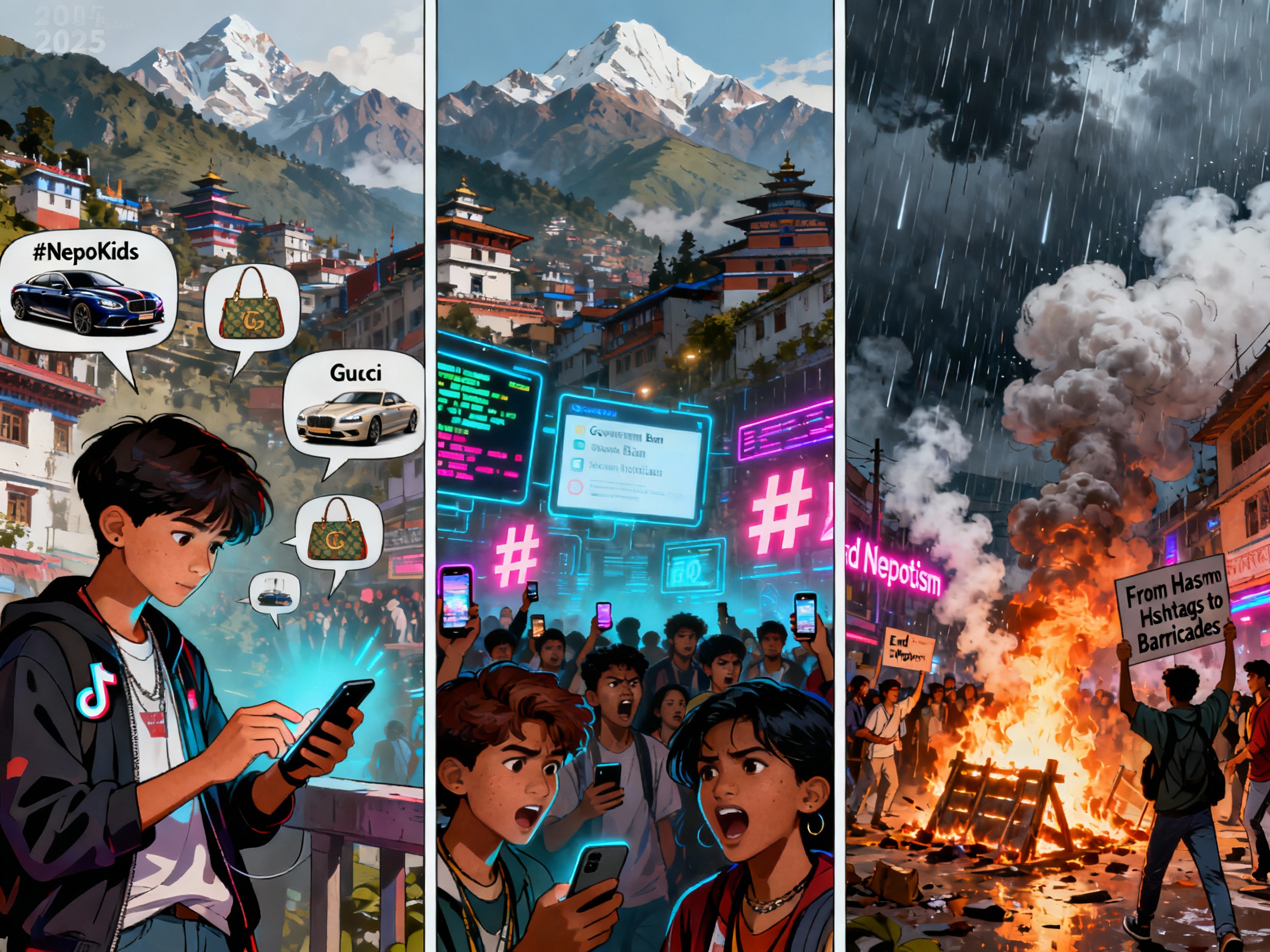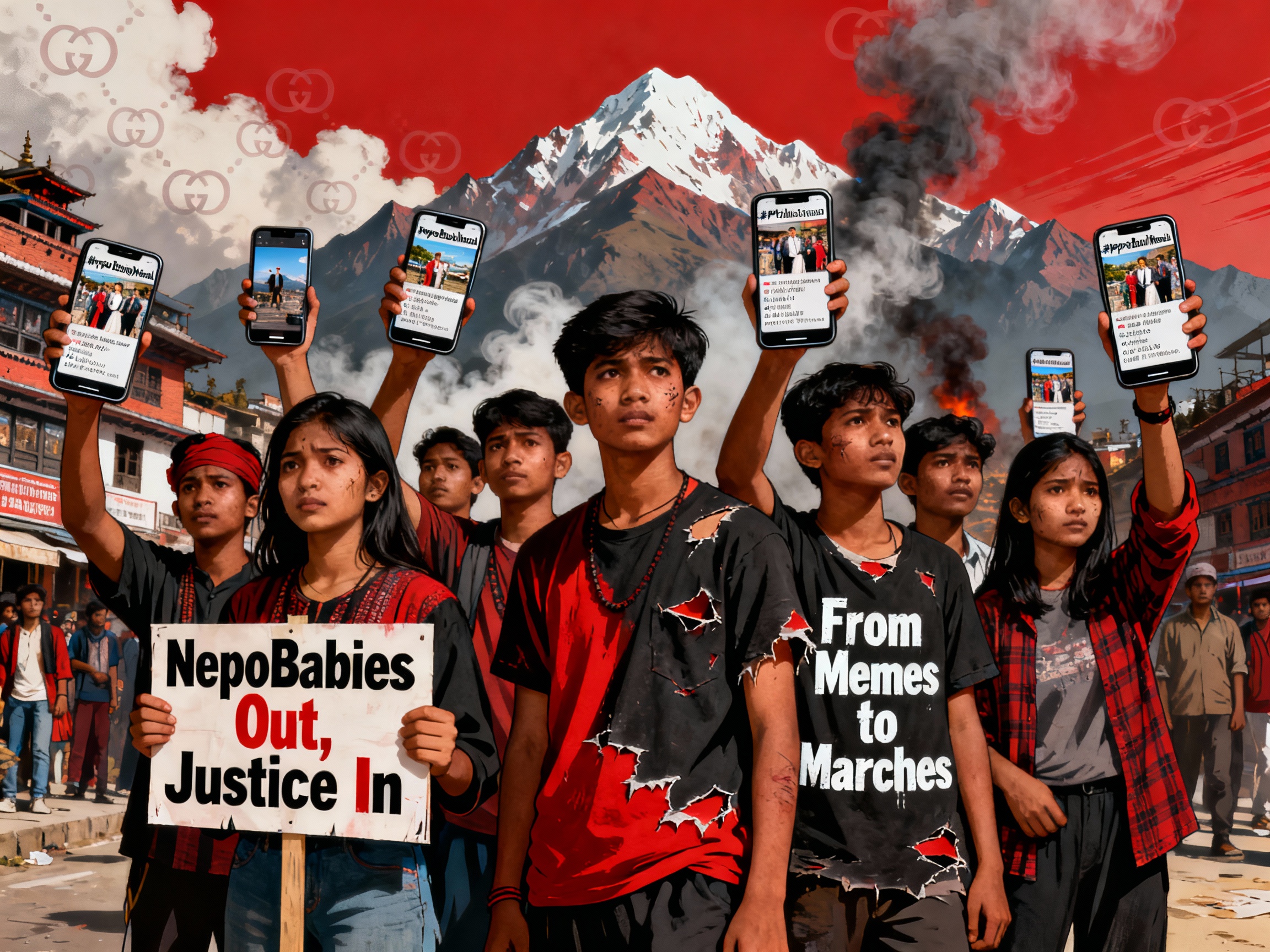
In the last months of 2025, Nepal became the stage for an unexpected social experiment. The term "nepobaby" - a contraction of "nepo baby", meaning "a child with family connections" - migrated from Western social media into the Nepali discourse. Initially, it described those in Hollywood or music who build careers on parental influence. In Nepal, this meme acquired a local flavor: young TikTok and Reddit users began using hashtags like #NepoKids and #PoliticiansNepoBabyNebal to highlight the gap between the elite and the majority. This is not just a critique of luxury - it is a mirror of systemic issues where family privileges mask corruption and inequality.
Imagine: while millions of Nepalis work in factories abroad or pay taxes hoping for stability, politicians' children share photos from resorts, in branded outfits, and behind the wheels of imported cars. One viral TikTok video under #NepoKids poses a simple question: “Where does this money come from?”. Users note that such posts do not explain the sources - whether it be education in prestigious universities or accessories from Gucci and Louis Vuitton. On Reddit, complaints are even more direct: "Our taxes go to their cars and trips, while we return in coffins from abroad due to the lack of jobs at home." This contrast of poverty and glamour became a visual manifesto, where each post emphasized not personal weaknesses but cracks in the social fabric.
Analysts note that the "nepobaby" phenomenon is not a random trend but an echo of global digital culture. In India and the West, similar memes have already changed narratives about privileges, but in Nepal, they confronted the reality of a developing democracy. Here, where political clans have dominated for decades, hashtags have turned into a tool for mobilization. Photos of luxury cars, Cartier jewelry, and overseas vacations became symbols not only of personal success but of entrenched nepotism. The question "Who pays for this?" echoed in the minds of youth tired of unfulfilled promises.

Challenges of Criticism: Between Justice and Risk
Of course, such open criticism carries risks. Some commentators, including authors from the Kathmandu Post, emphasize: the focus should be on the system, not individuals. Accusations against politicians' children easily slide into cyberbullying - anonymous threats, mockery of appearance or personal life. This is not only unfair but also dilutes the essence: the real problem lies in the mechanisms that allow the elite to accumulate wealth at the expense of public resources. Nevertheless, the #NepoKids campaign achieved its goal - it brought corruption out of the shadows, making it a topic of everyday conversation.
Specific figures amplified the effect. Shrinkhala Khatiwada, Miss Nepal 2018 and daughter of a former health minister, became a target due to photos of travels and jewelry. Her family home was even set on fire during unrest - a tragic example of how online criticism spills into reality. Shivana Shrestha, a singer and wife of the son of a former prime minister, was associated with luxurious interiors. Smita Dahal, granddaughter of leader Pushpa Kamal Dahal, with luxury brand bags. Sogata Thapa, the son of the justice minister, symbolized "living large." Other names, like Binu Magar from the same family, added color. It is important to note: these examples came from users, not official investigations. Journalists caution against hasty conclusions, reminding that the blame lies with the politician parents, not the offspring.
This phenomenon illustrates how social media democratizes criticism. In Nepal, where traditional media is often cautious, TikTok and Reddit gave a voice to Gen Z - a generation raised on algorithms and global trends. But here, the meme did not remain virtual: it triggered a chain reaction, from online hashtags to street marches.
Timeline: From Hashtags to Barricades
Events unfolded rapidly, like a snowball in the Himalayas. Late August - early September 2025: hashtags #NepoKids and #PoliticiansNepoBabyNebal gain momentum. Users share screenshots of luxury, calling for reforms. On September 4, authorities impose a ban on TikTok, Telegram, and other platforms - allegedly for "national security." But the youth sees this as censorship: an attempt to silence voices exposing the elite.
The response was swift. On September 8, thousands of students take to the streets of Kathmandu with signs "Close corruption, not social media!" and "Youth against nepotism." Protests quickly escalate: September 9–15 - clashes with police, storming of parliament, arson. Tear gas, gunfire - the outcome is tragic: between 19 and 31 dead, according to different estimates. On September 14, the social media ban is lifted, a curfew is imposed, but demands grow: the resignation of the prime minister, anti-corruption measures.
On September 16, Interior Minister Ramesh Lekhak resigns. Prime Minister K.P. Sharma Oli promises compensation to families, but the streets do not empty. On September 20, parliament votes for an independent anti-corruption body and asset verification of officials. By the end of September, Oli announces his departure - the culmination of pressure. The Guardian calls this "one of the largest protests in modern Nepali history." The social media ban was "the last straw," but the roots lie in the accumulated anger from #NepoKids.
Analyzing the timeline, it is clear how digital impulse transitions into physical action. Social media not only spread the idea but also coordinated actions: live broadcasts, barricade maps. Slogans like "Taxes - not for Gucci" or "Give the country back to us" directly echo the memes. Moneycontrol emphasizes: this is not a revolt against platforms, but a paradigm shift - from passive discontent to active demand for justice.

The Role of "nepobaby" in Protests: From Meme to Movement
The "nepobaby" phenomenon became a lens through which the youth saw the entire system. Activists told the BBC: "We want to stop corruption and take back the country." The campaign showed how the elite's privileges are not an abstraction but a daily reality: politicians' children study abroad (possibly on taxes), return with brands, while their peers struggle to survive. India Today quotes: "They come with Gucci, ours in coffins." This is not rhetoric of rage, but a quiet tally of contrasts that mobilized thousands.
In a broader sense, "nepobaby" introduced a new language into Nepali politics. Previously, corruption was discussed in abstract terms - "reforms," "transparency." Now it is personalized: through photos and videos. This made the abstract tangible, and the criticism viral. Hindustan Times notes that the protests evolved from online complaints to street pressure, where censorship became a catalyst. Gen Z, accustomed to global narratives, adapted the Western meme to local realities, showing how digitalization amplifies social movements in developing countries.
Outcomes: Victories, Risks, and Horizons
The results are impressive but ambiguous. Politically: the resignations of Lekhak and Oli are a direct triumph of the streets. The social media ban is lifted, parliament passed a resolution on asset verification of officials and the creation of an anti-corruption body. Part of the elite publicly renounced privileges - a step towards symbolic transparency. But experts are skeptical: new structures are just starting, and systemic reforms require years.
Socially, the phenomenon left a mark. It raised awareness of inequality but provoked polarization. Kathmandu Post warns of cyberbullying: threats to families, arson - the price of network anonymity. NDTV reports cases where the elite's children became targets not only of words but of actions. On the other hand, it changed the discourse: the youth now links personal privileges with the state machine, demanding accountability.
Long-term prospects are open. "Nepobaby" entered the lexicon as a label for clan-based politics - a reminder that power is accountable. India Today sees the protests not as an episode but as a shift: Gen Z is ready for repeated actions if the elite tries to silence criticism. In a global context, this is an example of how memes from show business mutate into tools of social engineering. In Nepal, at the intersection of tradition and digital, such a phenomenon can become a model for other Asian countries - a quiet but relentless pressure on the elite.
Conclusion: A New Language of Justice
The "nepobaby" phenomenon in Nepal is a story of how simple words and images reshape reality. A meme born in Western charts became a bridge in Nepali networks between virtual anger and real changes. It showed the contrast: the elite's glamour against the shadows of the majority. When censorship tried to interrupt the conversation, the streets took the word, leading to resignations and promises of reforms. The key gift is not only political shifts but also language: "nepobaby" now means "enough hiding behind connections."
This is a reminder that in the age of social media, power loses its monopoly on narrative. Nepal, with its young population and fragile democracy, showed the way: from hashtag to history. The future depends on whether promises turn into actions - but the seed is sown. In the quiet echo of #NepoKids, the voice of a generation demanding not luxury, but equality, is heard.

Leave a comment
Comment